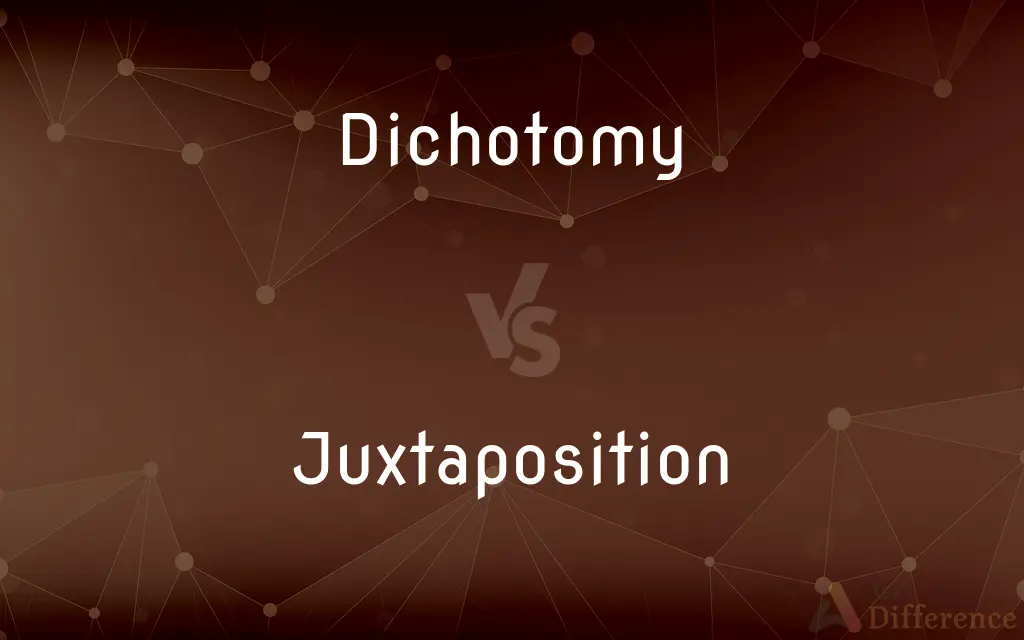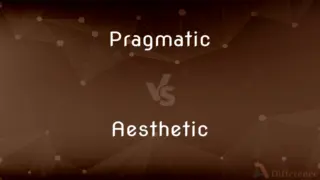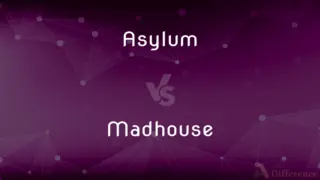Dichotomy vs. Juxtaposition — What's the Difference?
By Maham Liaqat & Urooj Arif — Updated on March 18, 2024
Dichotomy refers to a division into two parts that are often contradictory or mutually exclusive, while juxtaposition places two elements close together for contrasting effect.

Difference Between Dichotomy and Juxtaposition
Table of Contents
ADVERTISEMENT
Key Differences
Dichotomy is a concept used to describe a division or contrast between two things that are presented as being completely opposite or entirely different. It often implies a clear and distinct separation within a theoretical framework or philosophical concept. On the other hand, juxtaposition involves placing two or more ideas, characters, actions, or objects close together or side by side, especially for the purpose of comparison, contrast, or highlighting differences or similarities without necessarily implying a direct opposition as with dichotomy.
In literature, a dichotomy might be used to explore themes of good versus evil, where these two elements are treated as mutually exclusive and fundamentally opposite. This approach allows for a clear distinction between characters, ideas, or forces within a narrative. Whereas juxtaposition might place a virtuous character next to a morally ambiguous one not to suggest direct opposition but to highlight the complexity of morality and human nature, emphasizing the nuanced differences and similarities between them.
Dichotomy often serves as a tool for analytical thinking and problem-solving, breaking down complex systems or ideas into two fundamentally opposed or contrasting parts for easier understanding and examination. It simplifies the complexity of subjects by categorizing them into binary opposites. Conversely, juxtaposition allows for a more nuanced examination of the relationship between different elements, encouraging a deeper reflection on how these elements interact and affect each other, which can lead to a more comprehensive understanding of the subject matter.
In the realm of visual arts, dichotomy might manifest in the form of contrasting themes, colors, or subjects within a single piece, aiming to highlight the tension or conflict between two opposing elements. Juxtaposition, meanwhile, might place disparate visual elements close together to create an interesting or thought-provoking contrast, encouraging viewers to consider the relationship between these elements and the broader context of the artwork.
The use of dichotomy and juxtaposition can significantly affect the audience's perception and interpretation of a work, whether it be in literature, philosophy, art, or film. Dichotomy tends to present an either/or scenario, pushing for a choice or a side, thereby simplifying complex issues into more digestible segments. Juxtaposition, by contrast, invites contemplation and exploration of the spaces between the elements it compares, enriching the audience's understanding through contrast without forcing a binary decision.
ADVERTISEMENT
Comparison Chart
Definition
Division into two mutually exclusive or contradictory groups.
Placing elements close together for contrast or comparison.
Implication
Implies opposition or conflict between two parts.
Suggests comparison or contrast without inherent conflict.
Usage in Literature
Explores themes by presenting them as opposites.
Highlights complexities or nuances between elements.
Analytical Tool
Simplifies analysis by categorizing into binaries.
Encourages deeper reflection on relationships between elements.
Effect on Audience
Promotes a clear distinction and choice between opposites.
Invites contemplation and nuanced understanding.
Compare with Definitions
Dichotomy
Promotes clear distinctions in analytical thinking.
Economists frequently employ the dichotomy of supply and demand to explain market behaviors.
Juxtaposition
Encourages nuanced understanding.
Juxtaposition in art often invites viewers to find their interpretations of contrasting elements.
Dichotomy
Encourages choosing sides or perspectives.
Political discussions are often framed within a dichotomy, forcing a choice between two opposing views.
Juxtaposition
Used to explore similarities and differences.
The author's juxtaposition of the protagonist's youth and old age invites reflection on growth and change.
Dichotomy
Division into two opposite parts.
The dichotomy of light and darkness is a common theme in literature.
Juxtaposition
Does not necessarily imply a binary opposition.
The photographer’s juxtaposition of natural and man-made objects questions the concept of beauty.
Dichotomy
Used to highlight fundamental differences.
The dichotomy between science and religion often sparks debate.
Juxtaposition
Placing elements close for contrast.
The juxtaposition of wealth and poverty in the film highlights societal inequality.
Dichotomy
Simplifies complex concepts into binaries.
The nature versus nurture dichotomy simplifies human behavior analysis.
Juxtaposition
Enriches narratives without forcing opposition.
The novel’s juxtaposition of modern and historical settings enriches its thematic depth.
Dichotomy
A dichotomy is a partition of a whole (or a set) into two parts (subsets). In other words, this couple of parts must be jointly exhaustive: everything must belong to one part or the other, and mutually exclusive: nothing can belong simultaneously to both parts.Such a partition is also frequently called a bipartition.
Juxtaposition
Juxtaposition is an act or instance of placing two elements close together or side by side. This is often done in order to compare/contrast the two, to show similarities or differences, etc.
Dichotomy
A division or contrast between two things that are or are represented as being opposed or entirely different
A rigid dichotomy between science and mysticism
Juxtaposition
The act or an instance of juxtaposing or the state of being juxtaposed.
Dichotomy
Repeated branching into two equal parts.
Juxtaposition
The nearness of objects with little or no delimiter.
Dichotomy
A division into two contrasting parts or categories
The dichotomy between rural and urban communities.
Regards the division between nature and nurture as a false dichotomy.
Juxtaposition
(grammar) An absence of linking elements in a group of words that are listed together.
Example: mother father instead of mother and father
Dichotomy
(Astronomy) The phase of the moon, Mercury, or Venus when half of the disk is illuminated.
Juxtaposition
(mathematics) An absence of operators in an expression.
Using juxtaposition for multiplication saves space when writing longer expressions. collapses to .
Dichotomy
(Botany) Branching characterized by successive forking into two approximately equal divisions.
Juxtaposition
The extra emphasis given to a comparison when the contrasted objects are close together.
There was a poignant juxtaposition between the boys laughing in the street and the girl crying on the balcony above.
Dichotomy
A separation or division into two; a distinction that results in such a division.
Juxtaposition
(arts) Two or more contrasting sounds, colours, styles etc. placed together for stylistic effect.
The juxtaposition of the bright yellows on the dark background made the painting appear three dimensional.
Dichotomy
Such a division involving apparently incompatible or opposite principles; a duality.
Juxtaposition
(rhetoric) The close placement of two ideas to imply a link that may not exist.
Example: In 1965 the government was elected; in 1965 the economy took a dive.
Dichotomy
(logic) The division of a class into two disjoint subclasses that are together comprehensive, as the division of man into white and not white.
Juxtaposition
To place in juxtaposition.
Dichotomy
The division of a genus into two species; a division into two subordinate parts.
Juxtaposition
A placing or being placed in nearness or contiguity, or side by side; as, a juxtaposition of words.
Parts that are united by a a mere juxtaposition.
Juxtaposition is a very unsafe criterion of continuity.
Dichotomy
(astronomy) A phase of the moon when it appears half lit and half dark, as at the quadratures.
Juxtaposition
The act of positioning close together (or side by side);
It is the result of the juxtaposition of contrasting colors
Dichotomy
(botany) Division and subdivision; bifurcation, as of a stem of a plant or a vein of the body into two parts as it proceeds from its origin; often successive.
Juxtaposition
A side-by-side position
Dichotomy
A cutting in two; a division.
A general breach or dichotomy with their church.
Dichotomy
Division or distribution of genera into two species; division into two subordinate parts.
Dichotomy
That phase of the moon in which it appears bisected, or shows only half its disk, as at the quadratures.
Dichotomy
Successive division and subdivision, as of a stem of a plant or a vein of the body, into two parts as it proceeds from its origin; successive bifurcation.
Dichotomy
The place where a stem or vein is forked.
Dichotomy
Division into two; especially, the division of a class into two subclasses opposed to each other by contradiction, as the division of the term man into white and not white.
Dichotomy
Being twofold; a classification into two opposed parts or subclasses;
The dichotomy between eastern and western culture
Common Curiosities
Can dichotomy and juxtaposition be used together?
Yes, they can be used together, with dichotomy providing a clear contrast between two opposites and juxtaposition highlighting the nuanced relationships between those or other elements.
Why is dichotomy important in analysis?
Dichotomy simplifies complex issues by breaking them down into binary opposites, making them easier to understand and discuss.
What is a dichotomy?
A dichotomy is a division or contrast between two things that are represented as being entirely different or opposite.
What is the purpose of juxtaposition in literature?
In literature, juxtaposition is used to deepen the narrative by comparing and contrasting characters, settings, or themes, enhancing the complexity and richness of the work.
What makes juxtaposition effective in visual arts?
Juxtaposition in visual arts creates interesting contrasts, encouraging viewers to explore and interpret the relationships between juxtaposed elements, thereby enhancing engagement and understanding.
Can dichotomy be too simplistic?
Yes, relying solely on dichotomies can oversimplify complex issues, ignoring the nuanced and multifaceted nature of many subjects.
How do dichotomy and juxtaposition influence storytelling?
They enrich storytelling by offering different ways to explore and present relationships between characters, settings, and themes, either by contrasting clear opposites or by placing elements in close relation for a more nuanced exploration.
Can juxtaposition change the meaning of an artwork?
Yes, juxtaposition can significantly alter the interpretation and perceived meaning of an artwork by placing elements in a context that changes how they are viewed and understood.
How does juxtaposition work?
Juxtaposition involves placing two or more elements close together or side by side to highlight their differences or similarities, usually for comparative or contrasting effect.
Is the use of dichotomy universal across cultures?
While the concept of dichotomy is found worldwide, its application and the specific dichotomies emphasized can vary significantly between cultures.
Is juxtaposition always obvious?
Not always; sometimes, the effectiveness of juxtaposition lies in its subtlety, inviting the audience to make deeper connections between elements that are not immediately apparent.
What challenges can arise from using dichotomies?
Dichotomies can lead to oversimplification, reducing complex issues to binary choices and potentially ignoring important nuances.
How does dichotomy affect audience perception?
Dichotomy can clarify choices and perspectives by presenting clear-cut opposites, influencing the audience to consider these distinctions.
Share Your Discovery

Previous Comparison
Pragmatic vs. Aesthetic
Next Comparison
Asylum vs. MadhouseAuthor Spotlight
Written by
Maham LiaqatCo-written by
Urooj ArifUrooj is a skilled content writer at Ask Difference, known for her exceptional ability to simplify complex topics into engaging and informative content. With a passion for research and a flair for clear, concise writing, she consistently delivers articles that resonate with our diverse audience.














































